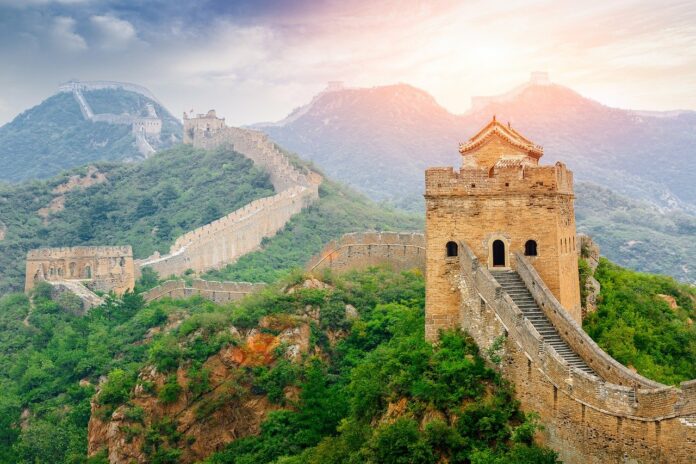The Great Wall of China is one of the most iconic and impressive architectural marvels in the world. Built over centuries, it stretches thousands of miles across northern China, traversing rugged terrain and awe-inspiring landscapes.
Construction of the Great Wall began over 2,000 years ago, during the Qin Dynasty (around 220–206 BCE). It was initially built to protect China from invading nomadic tribes from the north. Over the centuries, various dynasties expanded and reinforced the wall, resulting in the magnificent structure we see today.
Length and Structure
The Great Wall of China is incredibly long, with estimates ranging from 13,000 to 21,000 miles (21,000 to 34,000 kilometers). It consists of a series of walls, towers, and fortifications, built using a variety of materials, including stone, brick, earth, and wood.
Purpose and Significance
The primary purpose of the Great Wall was defensive, serving as a barrier to prevent invasions and protect Chinese territory. However, it also facilitated trade, communication, and cultural exchange along the Silk Road, linking China with Central Asia and beyond.
Tourist Attraction
Today, the Great Wall of China is one of the most visited tourist attractions in the world. Millions of people from around the globe travel to China each year to marvel at its grandeur, walk along its ancient pathways, and soak in its rich history.
Despite its enduring strength, the Great Wall faces numerous challenges, including erosion, vandalism, and urban development. Efforts are underway to preserve and protect this cultural heritage site for future generations to enjoy.
Interesting Facts About the Great Wall of China
- The Great Wall is not a single continuous wall but a series of interconnected walls, fortifications, and trenches.
- It is one of the largest construction projects ever undertaken by humans.
- The wall’s width varies from about 15 to 30 feet (4.5 to 9 meters), and its height ranges from 16 to 40 feet (5 to 12 meters).
- Contrary to popular belief, the Great Wall cannot be seen from space without aid.
- The mortar used to bind the bricks and stones of the wall contains a unique mixture of rice flour, lime, and water.
- It is estimated that over one million laborers, soldiers, and craftsmen worked on the construction of the Great Wall.
- The wall incorporates natural barriers like rivers, mountains, and cliffs into its design.
- Sections of the Great Wall have been restored and renovated over the years, while others remain in a state of disrepair.
- The Mutianyu and Badaling sections are among the most visited and well-preserved parts of the Great Wall.
- The wall’s construction materials and techniques varied depending on the region and the resources available.
- The Great Wall served as more than just a military defense system; it also facilitated trade, communication, and cultural exchange.
- Despite its name, the Great Wall was not visible to the nomadic tribes it aimed to deter.
- The wall’s watchtowers served as lookout points and signaling stations, allowing defenders to communicate over long distances.
- The Great Wall played a significant role in shaping China’s national identity and fostering a sense of unity among its people.
- Some sections of the Great Wall have been designated UNESCO World Heritage Sites.
- The wall’s construction involved a variety of innovative engineering techniques, including the use of rammed earth, brick kilns, and scaffolding.
- The wall’s strategic location along mountain ridges and plateaus provided defenders with a tactical advantage.
- The Great Wall is often called “Wanli Changcheng” in Chinese, which translates to “Long Wall of 10,000 Li.”
- Legend has it that the spirits of deceased workers are buried within the walls of the Great Wall to protect its integrity.
- The Great Wall’s construction spanned multiple dynasties, including the Qin, Han, Ming, and Qing Dynasties.
- The wall’s purpose evolved over time, adapting to changes in military technology, political landscapes, and economic priorities.
- The Great Wall’s construction required immense manpower, with workers often enduring harsh conditions and labor-intensive tasks.
- The wall’s design incorporated defensive features such as battlements, arrow loops, and trapdoors to repel invaders.
- Many myths and legends surround the Great Wall, including tales of supernatural beings, secret passageways, and hidden treasures.
- The Great Wall has inspired countless works of art, literature, and folklore throughout history.
- Sections of the Great Wall are illuminated at night, creating a breathtaking spectacle for visitors and locals alike.
- The wall’s construction involved significant logistical challenges, including transporting materials over long distances and navigating rugged terrain.
- The Great Wall was not always successful in preventing invasions, as determined enemies sometimes found ways to breach its defenses.
- The wall’s construction had profound social and economic impacts, shaping trade routes, settlement patterns, and cultural exchanges in the region.
- Despite its formidable size and strength, the Great Wall ultimately failed to prevent incursions by foreign powers, leading to its gradual decline in importance over time.
The Great Wall of China stands as a testament to human ingenuity, endurance, and perseverance. Its enduring legacy continues to captivate and inspire people around the world, reminding us of the power of human ambition and the importance of preserving our shared cultural heritage.
